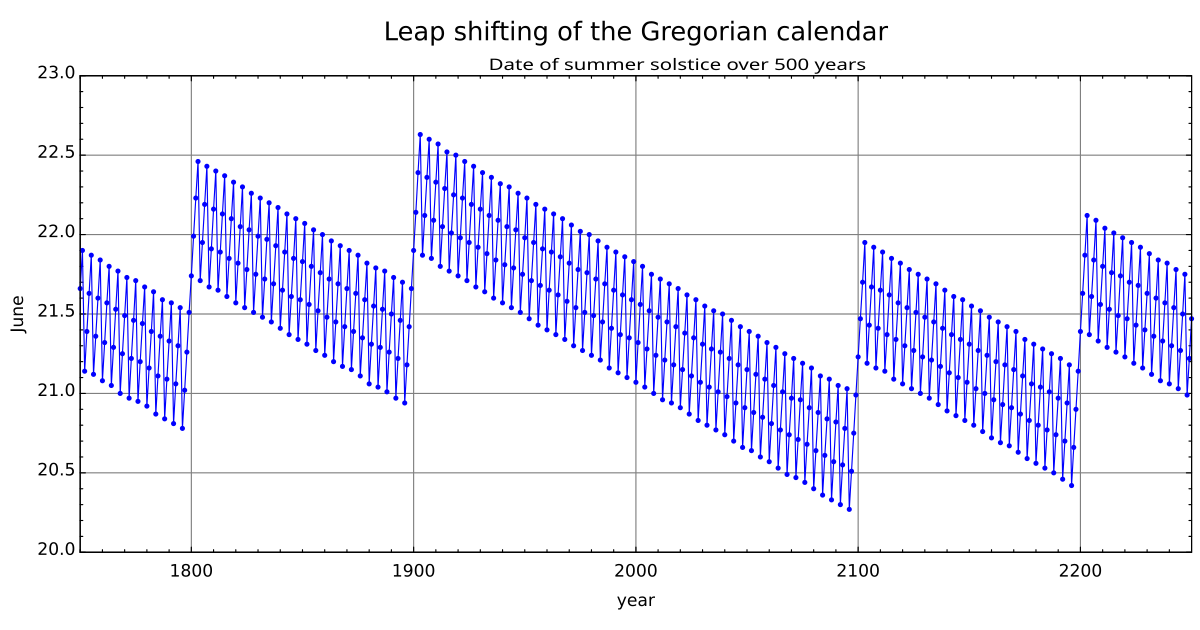cross-posted from: https://lemmy.world/post/19541930
Preferably a Holocene colander?
A consensus view was formally adopted by the IUGS in 2013, placing its start at 11,700 years before 2000 (9701 BC), about 300 years more recent than the epoch of the Holocene calendar.[6]
Some problems with Gregorian calendar
The Gregorian calendar improves the approximation made by the Julian calendar by skipping three Julian leap days in every 400 years, giving an average year of 365.2425 mean solar days long.[82] This approximation has an error of about one day per 3,030 years[s] with respect to the current value of the mean tropical year. However, because of the precession of the equinoxes, which is not constant, and the movement of the perihelion (which affects the Earth’s orbital speed) the error with respect to the astronomical vernal equinox is variable; using the average interval between vernal equinoxes near 2000 of 365.24237 days[83] implies an error closer to 1 day every 7,700 years. By any criterion, the Gregorian calendar is substantially more accurate than the 1 day in 128 years error of the Julian calendar (average year 365.25 days).
In the 19th century, Sir John Herschel proposed a modification to the Gregorian calendar with 969 leap days every 4,000 years, instead of 970 leap days that the Gregorian calendar would insert over the same period.[84] This would reduce the average year to 365.24225 days. Herschel’s proposal would make the year 4000, and multiples thereof, common instead of leap. While this modification has often been proposed since, it has never been officially adopted.[85]
On time scales of thousands of years, the Gregorian calendar falls behind the astronomical seasons. This is because the Earth’s speed of rotation is gradually slowing down, which makes each day slightly longer over time (see tidal acceleration and leap second) while the year maintains a more uniform duration.
Calendar seasonal error Gregorian calendar seasons difference
This image shows the difference between the Gregorian calendar and the astronomical seasons.
The y-axis is the date in June and the x-axis is Gregorian calendar years.
Each point is the date and time of the June solstice in that particular year. The error shifts by about a quarter of a day per year. Centurial years are ordinary years, unless they are divisible by 400, in which case they are leap years. This causes a correction in the years 1700, 1800, 1900, 2100, 2200, and 2300.
For instance, these corrections cause 23 December 1903 to be the latest December solstice, and 20 December 2096 to be the earliest solstice—about 2.35 days of variation compared with the astronomical event.
Proposed reforms The following are proposed reforms of the Gregorian calendar:
Holocene calendar
International Fixed Calendar (also called the International Perpetual calendar)
World Calendar
World Season Calendar
Leap week calendars
Pax Calendar
Symmetry454
Hanke–Henry Permanent Calendar



Probably Terran Standard. Whatever that is at the time.
Until there’s a rebellion and they break away from Earth control.
That makes me wonder if any sci fi series use enacting a local planetary time systems as a major part of a political declaration of independence from earth central authority.
I think that was in The Moon is a Harsh Mistress, iirc
I don’t think that timekeeping is an important subplot, if at all, but i could be wrong.
The supercomputer, though…
It’s not Earth-focused, but Eve Online had a minor subplot about how the coordination of time between multiple competing human civilizations became a major political problem because no one wanted to accept the system promoted by a rival empire.
It’s the symbolism. Of taking authority over their own lives back from the central authority.
Doesn’t really mean much in a practical sense. It’s more about making the people feel more empowered.
I recently read an interesting book called “the mimicking of known successes” which is a mystery/romance novel but the scifi world building is the part I most found interesting. Humanity had colonized Jupiter, but ultimately died out on earth due to complete ecological collapse. Anyways on the timekeeping subject they didn’t really talk much about time, but it was noted that inhabitants experience 2 day/night cycles per regular earthly circadian cycle, and people will generally end up on sleeping for 1 day/night cycles and being awake for 1 day/night cycle and people can be on different cycles entirely, so presumably time is tracked within a cycle and people just sleep through every other cycle
You mean orbital space stations?
Yes it was specifically human-made rings around the planet with platforms built on the rings for the human cities and factories and farms and trains running between the platforms. They also specifically burned the gas from the planet’s atmosphere to generate energy as well as produce atmosphere for breathing
Manuel O’Kelly-Davis would like a word.